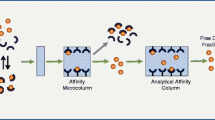Summary
The protein binding of salicylate was measured by continuous ultrafiltration (diafiltration) at 22°C in serum obtained from 5 healthy young (mean age: 27 years) and 5 healthy elderly (mean age: 73 years) male volunteers. Unbound salicylate increased disproportionately with increasing total salicylate concentration, up to 7000 µmol, in all sera. The fraction bound of salicylate was significantly lower in sera from elderly but this was not due to decreased albumin or total protein concentrations. The binding of salicylate to serum proteins was characterized by two classes of binding sites. The high affinity site had an association constant of either 94901/mol (young) or 75601/mol (elderly) and the number of binding sites was either 4.7 (young) or 3.7 (elderly). The total binding capacity of the low affinity site, 1121/mol, in sera from elderly was significantly less than the binding capacity, 631l/mol, in sera from young. Differences in binding capacity of the low affinity site partially accounted for a two to three-fold increase in the salicylate free fraction in elderly sera. These data suggest that age-related differences in serum protein binding may influence salicylate pharmacokinetics.
Similar content being viewed by others
References
Bayles TB (1969) Salicylate therapy in rheumatoid arthritis. Med Clin North Am 52: 703–706
Blatt WF, Robinson SM, Bixler JJ (1968) Membrane ultrafiltration: the diafiltration technique and its application to microsolute exchange and binding phenomena. Anal Biochem 26: 151–173
Borga O, Odar-Cederlof I, Ringberger V, Norlin A (1976) Protein binding of salicylate in uremic and normal plasma. Clin Pharmacol Ther 20: 464–475
Campion DS, Olsen R (1974) Measurement of drug displacement by continuous ultrafiltration. J Pharm Sci 63: 247–252
Costello PB, Green FA, Jung CY (1982) Free versus bound salicylate concentration in adults and children with chronic inflammatory joint disease. Arthritis Rheum 25: 32–37
Cuny G, Royer RJ, Mur JM, Serot JM, Faure G, Netten P, Maillard A, Pein F (1979) Pharmacokinetics of salicylates in the elderly. Gerontology 25: 49–55
Ekstrand R, Alvan G, Borga O (1979) Concentration dependent plasma protein binding of salicylate in rheumatoid patients. Clin Pharmacokin et 4: 137–143
Furst DE, Tozer TN, Melmon KL (1979) Salicylate clearance, the resultant of protein binding and metabolism. Clin Pharmacol Ther 26: 380–389
Geddes R, White PM (1978) Drug binding in human serum albumin as assayed by diafiltration and fluorimetry. Biochem Pharmacol 28: 2285–2288
Gram L, Flachs H, Wurtz-Jorgensen A, Parnas J, Anderson B (1979) Sodium valproate, serum level and clinical effect in epilepsy: a controlled study. Epilepsia 20: 303–313
Greenblatt DJ (1979) Reduced serum albumin concentration in the elderly: a report from the Boston Collaborative Drug Surveillance Program. J Am Geriatr Soc 27: 20–22
Greenblatt DJ, Sellers EM, Shader RI (1982) Drug disposition in old age. N Engl J Med 306: 1081–1088
Greenblatt DJ, Sellers EM, Koch-Weser J (1982) Importance of protein binding for the interpretation of serum or plasma drug concentrations. J Clin Pharmacol 22: 259–263
Greene DS, Nightingale CH (1976) A new method of calculating protein binding parameters obtained from diafiltration methods. Acad Pharm Sci Abstr 6: 117
Hayes MJ, Langman MJS, Short AH (1975) Changes in drug metabolism with increasing age; 1. Warfarin binding and plasma proteins. Br J Clin Pharmacol 2: 69–72
Klotz I (1982) Number of receptor sites from Scatchard graphs: facts and fantasies. Science 217: 1347–1349
Levy G (1965) Pharmacokinetics of salicylate elimination in man. J Pharm Sci 54: 959–967
Mather LE, Tucker GT, Pflug AE, Linorop MJ, Wilkerson C (1975) Meperidine kinetics in man; intravenous injection in surgical patients and volunteers. Clin Pharmacol Ther 17: 21–30
McMenamy RH, Dintzis HM, Watson F (1971) Cyanogen bromide fragments of human serum albumin. J Biol Chem 246: 4744–4750
Meffin PJ, Robert RW, Windle RA, Harapat S, Peters FA, Harrison DC (1979) Role of concentration dependent plasma protein binding in disopyramide disposition. J Pharmacokinet Biopharm 7: 29–46
Meyers EN, Bernstein JM, Fostiropolous G (1965) Salicylate ototoxicity. N Engl J Med 273: 587–590
Miller AK, Adir J, Vestal RE (1978) Tolbutamide binding to plasma proteins of young and old human subjects. J Pharm Sci 67: 1192–1193
Morgan E, Kelly P, Nies K, Porter WW, Paulus HE (1973) Tinnitus as an indicator of therapeutic serum salicylate levels. J Am Med Assoc 226: 142–145
Ouslander J (1981) Drug therapy in the elderly. Ann Intern Med 95: 711–722
Pickart L (1983) Increased ratio of plasma free fatty acids during normal aging and in patients with coronary heart disease. Atherosclerosis 46: 21–28
Rubin GM, Tozer TN, Oie S (1983) Concentration dependence of salicylate distribution. J Pharm Pharmacol 35: 115–117
Scatchard G (1949) The attraction of proteins for small molecules and ions. Ann NY Acad Sci 51: 660–672
Schwartz PA, Greene DS, Rhodes CT (1980) Effect of sodium oleate on salicylic acid binding to human serum albumin. J Pharm Sci 69: 1345–1347
Shah VP, Wallace SM, Riegelman S (1974) Microultrafiltration technique for drug-protein binding determination in plasma. J Pharm Sci 63: 1364–1367
Steele WH, Boobis SW, Moore MR, Goldberg A, Brodie MJ (1978) Protein binding of salicylate in cutaneous hepatic porphyria. Eur J Clin Pharmacol 13: 309–313
Wallace S, Whiting B (1976) Factors affecting drug binding in plasma of elderly patients. Br J Clin Pract 3: 327–330
Wosilait WD (1976) Theoretical analysis of the binding of salicylate by human serum albumin: the relationship between free and bound drug and therapeutic levels. Eur J Clin Pharmacol 9: 285–290
Zaroslinski JF, Keresztes-Nagy S, Mais RF, Oester YT (1974) The effect of temperature on the binding of salicylate by human serum albumin. Biochem Pharmacol 23: 1767–1776
Author information
Authors and Affiliations
Rights and permissions
About this article
Cite this article
Lesko, L.J., Narang, P.K., Yeager, L. et al. Salicylate protein binding in serum from young and elderly subjects as measured by diafiltration. Eur J Clin Pharmacol 28, 339–345 (1985). https://doi.org/10.1007/BF00543334
Received:
Accepted:
Issue Date:
DOI: https://doi.org/10.1007/BF00543334




